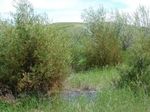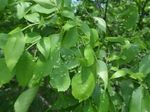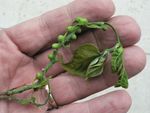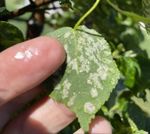Tree Pest Alert - SDSU Extension
←
→
Page content transcription
If your browser does not render page correctly, please read the page content below
Tree Pest Alert
June 2 Volume 19, Number 16
In This Issue Plant development for the growing
Plant Development .................................................................... 1
Treatments to begin now........................................................... 1
season
Timely topic ............................................................................... 1
While April was warm, it cooled down in May, which
Emerald ash borer update ..................................................... 1
Pine wilt disease found in Aberdeen ..................................... 2 slowed plant development. Now we are at about 500
Winter injury still appearing on trees ..................................... 3 growing degree days (GDD) in Sioux Falls, right where
E-samples ................................................................................. 4 we typically are by early June.
Erineum mites on linden ........................................................ 4
Maple bladder gall mite on silver maple ................................ 4
Samples received/site visits ...................................................... 4
Davison County (SNEED on spruce)..................................... 4
Faulk County (frost injury on ash and hackberry) .................. 5
Kingsbury County (hackberry bud gall and witches’-broom) . 5
Lincoln County (ash bead gall mite) ...................................... 5
Minnehaha County (ash bullet gall midge) ............................ 5
Samples
John Ball, Professor, SDSU Extension Forestry Specialist & South
Dakota Department of Agriculture and Natural Resources Forest
Health Specialist
Email: john.ball@sdstate.edu The Miss Kim lilacs are in bloom along with the black
locust. The appearance of the fragrant white flowers of
Phone: 605-688-4737 (office), 605-695-2503 (cell)
the black locust are also a sign that emerald ash borer
Samples sent to: John Ball emergence has begun. The insect started flying in Sioux
Agronomy, Horticulture and Plant Science Department Rm 314, Berg
Falls right on schedule – just like the swallows to San
Agricultural Hall, Box 2207A
South Dakota State University Juan Capistrano but not as welcomed!
Brookings, SD 57007-0996
Note: samples containing living tissue may only be accepted from Treatments to Begin Now
South Dakota. Please do not send samples of plants or insects from
other states. If you live outside of South Dakota and have a question, Now that the growing season is in full swing there are
please send a digital picture of the pest or problem. numerous treatments to be applied. These treatments
Any treatment recommendations, including those identifying specific are necessary to protect the plant from becoming
pesticides, are for the convenience of the reader. Pesticides mentioned infested or infected by a pest or pathogen. Waiting until
in this publication are generally those that are most commonly you see symptoms of an infestation or infection is
available to the public in South Dakota and the inclusion of a product
shall not be taken as an endorsement or the exclusion a criticism usually too late for effective treatments.
regarding effectiveness. Please read and follow all label instructions as
the label is the final authority for a product’s use on a pest or plant. Clearwing ash borer (Podosesia syringae) treatment
Products requiring a commercial pesticide license are occasionally with an insecticide containing permethrin as an active
mentioned if there are limited options available. These products will be ingredient also begin now. The bark must be sprayed to
identified as such, but it is the reader’s responsibility to determine if
they can legally apply any products identified in this publication. protect the tree as the insecticide will kill the adults as
they are walking on the bark to lay their eggs. The
Reviewed by Master Gardeners: Bess Pallares, Carrie Moore, and insecticide will also kill the newly hatched larvae before
Dawnee Lebeau
they burrow into the wood. Trunk injections or soil
The South Dakota Department of Agriculture and South Dakota State treatments with imidacloprid to kill the insect once it
University are recipients of Federal funds. In accordance with Federal
law and U.S. Department of Agriculture policy, this institution is
burrows into the tree are ineffective.
prohibited from discriminating on the basis of race, color, national
origin, sex, age, or disability (Not all prohibited bases apply to all The adults are usually out flying about a week or so after
programs.) To file a complaint of discrimination, write USDA, Director, Vanhouttee spireas begin to bloom and this shrub is
Office of Civil Rights, Room 326-W, Whitten Building, 1400 flowering throughout the state. You will know the adults
Independence Avenue, SW Washington, DC 20250-9410, or call (202)
720-5964 (voice and TDD). USDA is an equal opportunity provider and
are flying when you see the pupa skins sticking out of
employer. the emergence holes on infested trees.
This publication made possible through a grant from the USDA Forest Dothistroma treatments should be started now.
Service.
Dothistroma (Mycosphaerella pini) is a common disease
1of Austrian pines this year (also ponderosa pines in East are shed, usually in a couple of years. Shearing begins
River shelterbelts and interestingly in some Black Hills now and can be performed until the new needles along
communities). The most common symptoms are brown the candle are about half the size of the older needles.
needle tips with yellow to tan spots. The spots have now After that time, probably in a few more weeks, it will be
enlarged to form brown to reddish brown bands and too late.
sometimes fruiting structures can be seen in the bands.
However, as noted in several previous Pest Alerts, these
symptoms are common to many other diseases and
disorders. Only a lab can determine whether the
symptoms are due to this pathogen.
We have had two wet years, 2018 and 2019 which
resulted in a lot of infection in some trees. Last year was
dry but the disease persisted.
The treatment is a copper fungicide applied now as the
candles are expanding and repeated in late June and
again in mid-July. There are copper-containing
fungicides available such as Camelot® for those Shearing is only necessary if shaping an ornamental
individuals who must spray several or more trees. pine such as a mugo pine to keep it more compact.
Mancozeb fungicides, a mixture of zinc and manganese, Other than Christmas trees (and mugo pines) we do not
have shown effectiveness for treating the disease. usually shear pines in a formal shape.
Phomopsis twig blight (Phomopsis juniper-ovora) is Timely Topics
showing up on juniper (cedar) plantings throughout the
state. The typical symptoms of this disease are the
Emerald ash borer update
young growing tips turning pale green then light The coppery colored adults are beginning to fly in
yellowish green, then reddish brown and finally ash gray Lincoln and Minnehaha Counties. The adults are about
by late summer. Near the base of these infected twigs, 3/8 to 1/2 inch long but only 1/16 inch wide, so they are
you can find small, black fruiting bodies of the fungus. very slender, often described as torpedo shaped. The
The symptoms, and even the fruiting bodies, can be metallic coppery green color stands out against the bark.
easily confused with another common twig blight fungus
Kabatina juniperi so it is always a good idea to send in a The adults fly during the mid-day, about 10 am to 3 pm
sample for diagnosis. during sunny weather. They prefer day temperatures in
the 70s or lower 80s. If it is a nice day for a walk, it’s a
nice day for them to fly.
Despite coming from almost halfway around the world,
emerald ash borers are homebodies and content to hang
out on or near (within 300 feet) the tree from which they
emerged. While they can fly more than 15 miles (over
their 3- to 6-week lifetime, not generally in a day!), if
there are living ash near them, they will just stay there.
Pine wilt disease found in Aberdeen, South
Dakota
Phomopsis twig blight can be managed with applications
of a fungicide containing copper or propriconazole as the Aaron, the city forester in Aberdeen, noticed a Scotch
active ingredient applied now and continuing at two- pine (Pinus sylvestris) that died very quickly either last
week intervals until the spring growth matures, usually fall or this spring. When we arrived at the tree, it was
by mid-June, but it might be late June this year. clearly dead. The needles were discolored and hanging.
When you reached up to touch a twig, it breaks, rather
We should begin shearing pines now. Pines set only than bends.
terminal buds, not along the new shoots as do spruce
and fir, so the only time to shear them, removing a These are common symptoms of pine wilt disease. This
portion of the current season’s shoot growth, is during disease is caused by a nematode (as well as a blue-
the candle phase where the expanding new shoot is still stain fungus and possibility a bacteria) which stops the
tender. Removal of a portion of the shoot during this time flow of water through the tree during the summer, so it
will allow the new shoot to set buds. dries out by fall and dies.
If the pine is sheared after the new growth has The typical symptom pattern is for the tree to present
completed expansion and hardened, no new buds will be yellowing needles in the upper canopy by mid-summer.
set, and the shoot will dieback after the older needles The yellowing needles expand throughout the canopy
2and then turn tan by early fall. The tree usually dies by Winter freeze injury occurs when water in the cells
late fall, though may not be noticed until spring. The freezes. Despite the word ‘winter’ this injury often occurs
twigs are dry and snap easily. in late fall, not mid-winter. Woody plants go through a
process in the fall called acclimation where the free
water in cells is reduced and replaced with a natural
antifreeze. While decreasing day lengths are the trigger
for this process to begin, a gradual drop in temperatures
also ensures this process is completed by winter.
But a gradual drop in temperatures is not dependable
characteristic in South Dakota, a land defined by
extremes in weather. We had a relatively warm fall last
year. Rapid City saw an October where the
temperatures were still mild, reaching in the upper 70s
and 80s but then on October 27th, it dropped to -5oF.
Eastern and Central South Dakota also experience
temperature fluctuations, though not quite the extreme
as the western part of the state. It was still cold with
Sioux Falls reaching 14oF on October 27th, before
warming up again in early November (with a high of 81oF
on November 6th!).
Once the tree is cut down, the tree has dried out so
much that the wood has about half the weight of a
normal tree. The wood is also streaked with blue from
the blue-stain fungus. Cutting down the tree is the best
management of the disease. In the spring, longhorned
beetles fly out of the dead tree carrying the nematode to
nearby healthy trees.
Pine wilt disease has been gradually moving north in the
US since the 1970s. It was in southern Nebraska and
Missouri in 1980, the southern border of South Dakota
by the late 80s, the middle of the state by 2000 and now
covers the entire state from Spearfish to Canton,
Yankton to Aberdeen.
We can blame the gradual increase in summer
temperatures for the movement north. The disease is not
expressed until the mean July temperatures exceed 70-
72ºF. Aberdeen July mean temperatures were about
70ºF in the 1990s and were almost 73ºF in the past This abrupt temperature change caught many trees not
decade. We need global cooling to take care of this fully acclimated yet for winter. The freezing temperatures
problem but without that, Scotch pine should be resulted in ice rupturing cells in the shoots and buds.
removed from anyone’s planting list as we will gradually These dead cells resulted in shoot dieback and slow leaf
lose them all. out as the new leaves are being produced from new
shoots arising from adventitious buds.
The nematode is native to southern US so most of our
native pines, such as ponderosa pine (P. ponderosa), The injury is not uniform across all species. Some trees
are not killed by the disease. The most susceptible hosts shut down early in the fall regardless of the mild
are our introduced pines, Scotch pine, followed by temperatures. Buckeyes (Aesculus) and oaks (Quercus)
Austrian pine (P. nigra) and even mugo pine (P. mugo). almost always have dropped their leaves by mid-
Spruces are not susceptible to this disease. October. These species were not affected by freeze
injury.
Winter injury still appearing on trees
Other tree species seem to continue to maintain their
Most of the callers (or texters) mention the tree looked leaves if the weather is favorable. These trees, Siberian
fine last year and now are leafing out slowly or not at all. elm (Ulmus pumila) and hackberries (Celtis
Many of these same trees had leaves clinging on them occidentalis), are “fooled” by a warm early fall and are
for most of the winter. That is a clue to the problem – this susceptible to these abrupt cold snaps. This is one
might be winter-kill due to the fall freezing temperatures. reason (the other is our spring frost) that elms and
hackberries look sparse this spring. They were caught
by the sudden cold snap at the end of a mild October.
3This was an unusual, but not unprecedented, event. We
suffered far worse tree injury in past winters. Two
weather events that resulted in the loss of thousands of
trees, mostly elm, were the Halloween freeze of 1991
and the Armistice Day blizzard of 1940. These dates are
remembered for their mild temperatures (60 to 80oF) that
quickly turned extremely cold. There are Great Plains
forestry reports from both periods that noted Siberian
elms were killed by the thousands or suffered extensive
dieback.
This spring was also hard on elms and hackberries.
They were leafing out about the same time we had frost
in early May. Trees that leafed out earlier, lindens, had
the leaves harden enough they survived the cold. Other The adult mites move out from beneath the bark in the
trees, oak, had not leafed out yet and were spared. spring, just as the maple buds are beginning to open.
The crawl out to the new leaves and feed on the
E-samples underside of the blade. As they feed, they inject a
chemical into the leaves that reacts with plant hormones
Erineum mite on lindens
to form these galls.
I had a text about a “funny” growth on their linden
The adult mites lay eggs in these galls and the young
leaves. The concern was that this was a serious disease
mites feed within the gall until they emerge to also lay
and they wanted to know the treatment. The problem
eggs on any new foliage. If it is a dry summer, new
turned out not to be a pathogen but a mite. Tiny
growth stops early and there are no new galls. If the
eriophyid mites, about 1/100-inch long, are responsible
summer is wet (not likely this summer), new leaves
for the erineum, the felt-like patches that appear on the
continue to be produced and with that, new galls.
underside of the linden leaves. The felt is really
thousands of tiny hairs growing out of the leaf. If you When the new leaves stop appearing and summer is
look at the felt in the microscope (need at least 40x) you coming to an end, the mites move back to the bark and
might see the very tiny mites moving among the hairs. overwinter. There are usually several generations each
year.
The galls turn from green to red and yellow, and
eventually black by the end of the season. While the
galls can be numerous on a leaf, they do not usually
affect photosynthesis and the damage is more aesthetic
than health.
Samples received/Site visits
Davison County, Spruce problems
A disease that is appearing in many spruce samples is
spruce needle drop (aka sudden needle drop) also
known as SNEED. The pathogen associated with
The mites are common on boxelder, sugar maple, and
SNEED is Setomalonomma holmii. While it has not yet
lindens among other trees. Each host has its own mite
been proven that this pathogen is responsible for the
species, but the feeding and injury is the same – felt on
problem, it is often associated with tree presenting
the underside of the leaf and bumps on the upper side.
SNEED, older needles turning yellow or a yellow green
The mites feed by sucking cell contents from the leaves.
before dropping prematurely. Infected tree will often
The injury is usually minor, and treatments are not
have only the current year’s needles present.
necessary or effective.
Affected trees do not have the fruiting bodies appearing
Maple bladder gall mites on the foliage. Instead, the twigs on these shoots will be
covered with tiny black fruiting bodies of the pathogen.
I am receiving pictures of “growths” on silver maple
However, these same trees are also suffering other
leaves. These are maple bladder galls caused by the
stresses, such as drought, so there is most likely some
feeding of a tiny (less than 1/32-inch) eriophyid mites
other agent – an abiotic one – responsible for the
(Vasates quadripedes) feeding on the expanding foliage.
decline.
4Faulk County, Frost injury on ash and the proliferation of buds - and the mildew fungus causes
hackberry the buds to form stunted shoots.
I receive pictures of an ash, but the samples enclosed
were hackberries. The marginal discoloration on the ash
and the wilting of the hackberry leaves are like the frost
injury described in the next sample from Kingsbury
County.
Kingsbury County, Hackberry defoliation
The hackberries in the yard appeared defoliated with the
sparse foliage drooping and tattered. The problem was
not an insect or pathogen but the unpredictable spring
Most of the stunted shoots die the year they appear but
weather common to our state.
new brooms occur almost every year. Many hackberries
The freezing temperatures that occurred in early May are resistant to brooming while other trees have them
caught the hackberries just as they were leafing out. occur every year. Fortunately, the brooms are more an
Expanding leaves are tender and susceptible to frost annoyance than a problem.
injury. Trees such as basswoods that had leaf out earlier
and their foliage is tougher, more resistant to frost. Other Lincoln County, Ash bead gall mite
trees, such as oaks, still had their leaves in the buds so
Everyone is out closely looking at their ash trees and
were well protected from frost.
noticing anything that is out of the ordinary. This means
Hackberries and ash are the two trees that seem to start plenty of site visits to ash trees that are NOT related to
leafing out just when frosts are most likely to occur. The emerald ash borer.
good news is that the hackberries will soon put out new
Still, these can be interesting stops such as this one.
leaves and the damage will disappear.
The concern was the appearance of the leaves – the
The buds were also infested with hackberry budgall light-colored elongated blister-like bumps on the leaflets.
psyllid (Pachypsylla celtidisgemma). These are “cousins” These are the work of the ash bead gall mite, Aceria
to the hackberry leaf gall psyllid (P. celtidismamma). fraxini.
This is the insect responsible for the bumps appearing
on the underside of hackberry leaves. The difference
with the bud gall is the insect infested the buds and
these become enlarged. Either are serious threat to the
tree and not a concern.
The galls do not harm the tree (or the leaves). It just
makes they look a little unsightly, not the lethal threat of
emerald ash borer. But both share one thing in common,
they are introduced here and probably welcome each
other just as neighbors do when they meet in some other
country.
The other concern was the “funny” shoots that were Minnehaha County, Ash bullet gall midge
appearing through the tree. These are called witches’-
brooms. These clusters of shortened shoots, the This was another emerald ash borer call that turned out
brooms, detract from the appearance of the tree and are not to be the borer but an interesting pest. These colorful
one reason hackberry is not a poplar ornamental despite reddish bumps that appear along the veins are not due
being a tough, hardy tree. to a mite but a fly. This is the work of the ash bullet gall
midge (Dasineura pellex).
The witches’-broom are the work of two organisms, a
powdery mildew fungus (Sphaerotheca phytoptophila)
and an eriophyid mite (Eriophyes celtis, syn. Aceria
snetsingeri). It appears that the mite initiates the bloom –
5This midge does not harm the tree or the leaf. The
bullet-shaped galls may be considered unsightly by
some but that is the only concern. Ash has far bigger
problems right now.
6You can also read



























































